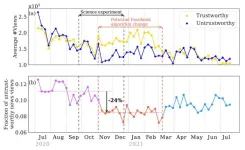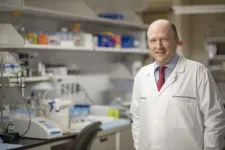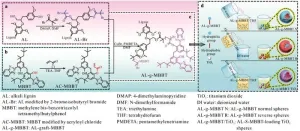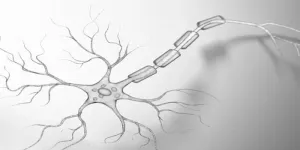(Press-News.org) For uncovering how a cell population helps ensure food, liquid and acid reflux are kept out of our airway – and instead sent to our GI tract – Laura Seeholzer is the winner of the 2024 Eppendorf & Science Prize for Neurobiology. Her findings, detailed in April in Science, have motivated her to study what’s happening with these cells in diseases where this critical protective reflex is compromised.
“These findings are crucial for understanding potentially life-saving reflexes that are activated in the airway, in response to noxious stimuli,” said Peter Stern, Senior Editor at Science, who oversaw the prize.
For most every breath we take and most every morsel or sip we consume, the lungs are protected. Air enters the lungs, but food, liquid and stomach acid are sent to the GI tract.
In a flash, however, this process can go wrong – a foreign agent can get into our airway. This can cause discomfort, at minimum. And at worst it can lead to airway blockage, acid-induced lung damage, or aspiration pneumonia – outcomes that occur frequently in people with neurological or esophageal disorders and which are a leading cause of aspiration pneumonia and mortality in older people.
Scientists already know that sensory systems in the upper airway, namely the larynx and trachea, rapidly detect the things that we need to exclude from our lungs. Innervated with sensory nerve fibers, the larynx and trachea respond to foreign agents – and clear them.
But scientists don’t know if the nerve fibers in the larynx and trachea act alone.
Seeholzer’s work uncovered another entity – neuroendocrine cells – that operate in the larynx and trachea, to play a protective role. In her prize essay, “(Don’t) take my breath away,” Seeholzer – a postdoctoral fellow at the University of California San Francisco – writes, “you should thank your neuroendocrine cells the next time you clear water or acid reflux out of your airway.”
Neuroendocrine (NE) cells are a rare group of epithelial cells throughout the larynx and trachea. They have been understood for their important role in repairing the airway epithelium after injury.
They had not been thought to be involved in airway protection.
However, because these cells are near sensory nerve fibers, Seeholzer and her colleagues speculated that they could be specialized sensory cells that play a role in protecting our lungs.
Seeholzer said she wasn’t even sure there were NE cells in the trachea and larynx when she started her work. “I started from the ground up, learning how these cells operate. I then used that to generate a hypothesis about their importance in the airway.”
Her efforts involved work in cells and in mice – and methods including calcium imaging, electrophysiology, and optogenetics.
The road wasn’t always easy.
“I had been studying NE cells for a year or two to figure out what they detect, which could inform what they do,” said Seeholzer. “I performed a sequencing experiment to see what the cells expressed. When I looked at the data, not many receptors were expressed that supported my hypothesis that these were sensory cells that could detect stimuli that could get into the airway. The sequencing led to all dead ends.”
Seeholzer did not give up, however. She spoke with David Julius, her mentor, and professor and chair of physiology at UCSF. She explained her sequencing work was not revealing what NE cells detected. “He encouraged me to step back and think about what they could be detecting, and to use that to nominate substances the NE cells could be frequently exposed to.”
That led to an “ah-hah!” moment she describes in her essay, where she changed how she set up her experiments. As a result, she discovered that water and strong acid solutions (like stomach acid) very consistently activated the NE cells.
She then sought to understand what the water and acid did to the cells. Using optogenetic techniques, she could specifically activate NE cells in mice. “When I did that, the mice started swallowing very quickly.” Seeholzer attached a device to the mice to study related changes in breathing. “I very consistently saw that activating NE cells led to swallows and to cough-like reflexes.” That supported her hypothesis that NE cells were detecting water and acid to elicit protective responses in the airway, to keep foreign substances out.
She says NE cells add another layer – on top of sensory neurons researchers have previously studied – giving full protection in the airway. This was further evidenced by experiments in mice in which the NE cells were knocked out; this led to the airway not being fully protected against foreign threats.
Now having done work in mice, Seeholzer wants to understand how these cells operate in healthy and diseased humans. Her findings suggest these cells are not functioning properly in people with dysphagia, which is the inability to swallow well – a major cause of mortality. “I’m really interested in looking at patients who aspirate frequently to see if there’s something going on with cells there,” she said. “And I’m interested in looking at what happens with these cells in people who smoke, where dysphagia is also more prevalent.”
There are also implications for people with refractory chronic cough, where the NE cells may be hyperactivated.
“Eppendorf and the journal Science have been awarding this prestigious prize since 2002,” said Axel Jahns, Vice President of Corporate Citizenship & Governmental Affairs at Eppendorf SE. “Since its initiation, the prize has acknowledged over 70 winners and finalists, who have gone on to become leading scientists in their field. Congratulations to Dr. Seeholzer on her amazing achievement in winning this year.”
Seeholzer expressed how her supportive lab environment made it possible to achieve the findings she did, even after significant obstacles. “The lab I’m in really made all the work fun and enjoyable,” she said.
Finalists
Rosemary J. Cater is a finalist for the prize, for her essay, “Food for thought.” Cater received her undergraduate degree and PhD from The University of Sydney. After completing her postdoctoral fellowship at Columbia University, she started her laboratory at the University of Queensland’s Institute for Molecular Bioscience in 2024. Her research uses an integrated structural biology approach to understand how nutrients obtained through the diet are transported across the blood-brain barrier.
Claudia Kathe is also a finalist for the prize, for her essay, “Rewiring movements.” Kathe received an undergraduate degree and PhD from King’s College London. After completing her postdoctoral fellowship at Swiss Federal Institute of Technology Lausanne (EPFL), she started her laboratory in the Department of Fundamental Neuroscience at the University of Lausanne in 2024. Her research investigates the reorganization of neuronal networks in the spinal cord in neurological disorders and its impact on sensorimotor function.
END
Prize recognizes discovery of how cell population protects our airways – and keeps them clear
Author: Meagan Phelan
2024-09-26
ELSE PRESS RELEASES FROM THIS DATE:
Team led by UMass Amherst debunks research showing Facebook’s news-feed algorithm curbs election misinformation
2024-09-26
AMHERST, Mass. – An interdisciplinary team of researchers led by the University of Massachusetts Amherst recently published work in the prestigious journal Science calling into question the conclusions of a widely reported study — published in Science in 2023 and funded by Meta — finding the social platform’s algorithms successfully filtered out untrustworthy news surrounding the 2020 election and were not major drivers of misinformation.
The UMass Amherst-led team’s work shows that the Meta-funded research was conducted during a short ...
Science publishes eLetter on 2023 study by Guess et al., as well as response by Guess et al.
2024-09-26
In 2023, Science published the study, “How do social media feed algorithms affect attitudes and behavior in an election campaign?” by Andrew Guess et al. Now, Chhandak Bagchi and colleagues – in an eLetter that will appear on the 2023 study – state that the study’s “reporting and conclusions did not account for a series of temporary emergency changes to Facebook’s news feed algorithm in the wake of the 2020 U.S. presidential election that were designed to diminish the spread of voter-fraud misinformation. This issue may have led readers to misinterpret ...
Supreme Court ruling could strip protections from up to 90 million acres of US wetlands
2024-09-26
New interpretations following the recent Sackett v. Environmental Protection Agency (EPA) United States Supreme Court ruling could strip federal protections from up to 90 million acres of U.S. nontidal wetlands – nearly all that exist in the coterminous US – according to a new study. The findings reveal the potential scope and impacts of the regulatory changes and highlight the uncertainty introduced by the ruling. Enacted in 1972, the Clean Water Act (CWA) aims to restore and protect the quality of U.S. waters ...
Ancient, buried wood inspires a possible low-cost method to store carbon
2024-09-26
Inspired by an ancient buried log, researchers present a novel method to remove and store atmospheric carbon for hundreds of years or more. It involves locking woody biomass away in “wood vaults.” The approach could provide a cost-effective solution to mitigate climate change. Achieving net-zero carbon dioxide (CO2) emissions is crucial for combating climate change, yet reducing fossil fuel emissions alone is insufficient to meet the Paris Agreement's targets. To achieve these goals, carbon dioxide removal (CDR) methods must be implemented, including engineering solutions, like direct air capture, ...
Removal of marine plastic fishery debris greatly reduces entanglement threat for endangered Hawaiian monk seals
2024-09-26
Large-scale removal of discarded fishing gear and other plastic debris from the waters of Northwestern Hawaii meaningfully reduced entanglement rates of endangered Hawaiian monk seals, according to a new study. The findings, which are drawn from more than four decades of data, offer promising evidence that marine debris cleanup programs are successful and that reducing plastic inputs and scaling up removal efforts could maximize conservation outcomes across marine ecosystems worldwide. Plastic pollution severely threatens marine ecosystems, ...
Climate change likely to increase diarrheal disease hospitalizations by 2100s
2024-09-26
By 2100, hospitalizations from diarrheal diseases are predicted to increase in the city of Dhaka in Bangladesh as a result of climate change, even if global warming stays under 2 degrees Celsius. Farhana Haque and colleagues from University College London, London School of Hygiene and Tropical Medicine and icddr,b report these findings in a new study published September 26 in the open access journal PLOS Neglected Tropical Diseases.
As one of the world’s most densely population cities, Dhaka deals with a high burden of diarrheal diseases. While some studies have looked at how weather affects diarrhea in Bangladesh, few have examined the future impact of climate ...
Cleveland Clinic researchers discover new bacterium that causes gut immunodeficiency
2024-09-26
September 26, 2024, Cleveland: Cleveland Clinic researchers have discovered a new bacterium that weakens the immune system in the gut, potentially contributing to certain inflammatory and infectious gut diseases.
The team identified the bacterium, Tomasiella immunophila (T. immunophila), which plays a key role in breaking down a crucial immune component of the gut’s multi-faceted protective immune barrier.
Identifying this bacterium is the first step to developing new treatments for a variety of inflammatory and infectious gut diseases. These conditions, including inflammatory ...
Research reveals impact of gut microbiome on hormone levels in mice
2024-09-26
Francis Crick Institute press release
Under strict embargo: 19:00hrs Thursday 26 September 2024
Peer reviewed
Experimental study
Animals
Researchers at the Francis Crick Institute have shown that the balance of bacteria in the gut can influence symptoms of hypopituitarism in mice.
They also showed that aspirin was able to improve hormone deficiency symptoms in mice with this condition.
People with mutations in a gene called Sox3 develop hypopituitarism, where the pituitary gland doesn’t ...
Lignin-based sunscreen offers natural and high-performance UV protection
2024-09-26
In a significant breakthrough for the cosmetics industry, researchers have developed a new type of sunscreen using lignin, a naturally abundant polymer, and titanium dioxide (TiO2). The study, led by Yarong Li and Zhiguang Tang, was published in the Journal of Bioresources and Bioproducts and details the innovative use of a dual-modified lignin sub-microsphere to enhance the SPF and improve the color of sunscreens.
Lignin, a byproduct of the pulp industry, is known for its UV-absorbing properties and antioxidant capabilities. However, its application in commercial sunscreens has been limited due ...
How are stretch reflexes modulated during voluntary movement?
2024-09-26
How did the bodies of animals, including ours, become such fine-tuned movement machines? How vertebrates coordinate the eternal tug-o-war between involuntary reflexes and seamless voluntary movements is a mystery that Francisco Valero-Cuevas’ Lab in USC Alfred E. Mann Department of Biomedical Engineering, set out to understand. The Lab’s newest computational paper published in the Proceedings of the National Academy of Sciences (PNAS) adds to the thought leadership about the processing of sensory information and control of reflexes during voluntary movements—with implications as to how its disruption could ...
LAST 30 PRESS RELEASES:
Global psychiatry mourns Professor Dan Stein, visionary who transformed mental health science across Africa and beyond
KIST develops eco-friendly palladium recovery technology to safeguard resource security
Statins significantly reduce mortality risk for adults with diabetes, regardless of cardiovascular risk
Brain immune cells may drive more damage in females than males with Alzheimer’s
Evidence-based recommendations empower clinicians to manage epilepsy in pregnancy
Fungus turns bark beetles’ defenses against them
There are new antivirals being tested for herpesviruses. Scientists now know how they work
CDI scientist, colleagues author review of global burden of fungus Candida auris
How does stroke influence speech comprehension?
B cells transiently unlock their plasticity, risking lymphoma development
Advanced AI dodel predicts spoken language outcomes in deaf children after cochlear implants
Multimodal imaging-based cerebral blood flow prediction model development in simulated microgravity
Accelerated streaming subgraph matching framework is faster, more robust, and scalable
Gestational diabetes rose every year in the US since 2016
OHSU researchers find breast cancer drug boosts leukemia treatment
Fear and medical misinformation regarding risk of progression or recurrence among patients with breast cancer
Glucagonlike peptide-1 receptor agonists and asthma risk in adolescents with obesity
Reviving dormant immunity: Millimeter waves reprogram the immunosuppressive microenvironment to potentiate immunotherapy without obvious side effects
Safety decision-making for autonomous vehicles integrating passenger physiological states by fNIRS
Fires could emit more air pollution than previously estimated
A new way to map how cells choose their fate
Numbers in our sights affect how we perceive space
SIMJ announces global collaborative book project in commemoration of its 75th anniversary
Air pollution exposure and birth weight
Obstructive sleep apnea risk and mental health conditions among older adults
How talking slows eye movements behind the wheel
The Ceramic Society of Japan’s Oxoate Ceramics Research Association launches new international book project
Heart-brain connection: international study reveals the role of the vagus nerve in keeping the heart young
Researchers identify Rb1 as a predictive biomarker for a new therapeutic strategy in some breast cancers
Survey reveals ethical gaps slowing AI adoption in pediatric surgery
[Press-News.org] Prize recognizes discovery of how cell population protects our airways – and keeps them clearAuthor: Meagan Phelan



